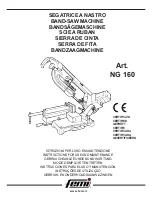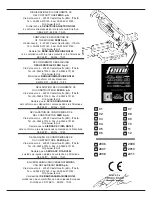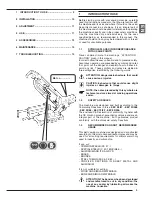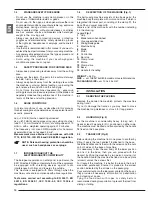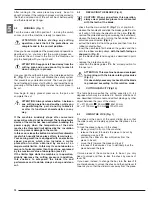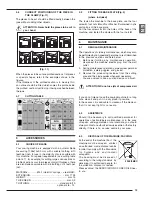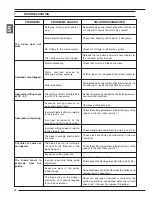
10
EN
1.4
STANDARD SAFETY PROCEDURS
- Do not use the machine in very damp places or in the
presence of inflammable liquids or gases.
- Do not use it in the open air when general weather and
environmental conditions are unfavourable (eg. explosive
atmospheres, during a storm or rain).
- Wear suitable clothes, without wide sleeves or articles
such as scarves, chains and bracelets which could get
caught in the moving parts.
- Always use personal protection devices: protective
goggles as recommended by safety standards, gloves
of the right size, headphones or earplugs, and hairnets if
necessary.
- Use the tools recommended in this manual if you want to
achieve the best performance from your sawing machine.
- Any power cable extensions must be type approved and
comply with safety standards.
- Avoid using the machine if your psycho-physical
condition are precarious or upset.
1.5
SAFETY PROCEDURS FOR FURTHER RISK
- Always keep processing residues away from the cutting
area.
- Always use the clamp. The parts to be cut must always
be held firmly in the clamp.
- Always keep hands away from the working areas while
the machine is moving: before loading or unloading the
part, release the run button on the hand grip.
- Do not force the machine unnecessarily : excessive
cutting pressure could cause rapid wear to the blade and
negatively influence the performance of the machine in
terms of finishes and cutting precision.
1.6
NOISE CONDITIONS
In normal conditions of use as described in this manual,
this belt sawing machine determines an equivalent level of
acoustic pressure:
Leq = 79,0 dB (A) when operating unloaded
Leq = 81,2 dB (A) during processing (eg. cutting of a steel
tube D. 130 mm thickness 10 mm), at cutting speed of 70
mt/min. with a weighted operating cycle of 2 minutes.
The frequency root mean RMS weighed for hand-arm
acceleration does not exceed 2.5m/s².
Measurement were obteined in compliance with UNI
7712, ISO 3740, ISO 3746 and CEE 89/392 regulation.
NOTE: Personal hearing protention should be
used, such as headphones or earplugs.
1.7
INFORMATION ABOUT THE
ELECTROMAGNETIC COMPATIBILITY
The European regulations on safety and, in particular, the
EEC Directive 89/336 contemplate that all the equipment
be equipped with shielding devices against radio
interferences both from and towards the outside.
This machine is equipped with filters through which the
machine is safe and in compliance with above regulations.
Tests were carried out according to EN 55011, EN
55014, EN 50082-1, IEC 1000-4-2, IEC 1000-4-4
regulations.
1.8
DESCRIPTION OF THE MACHINE (Fig. 1)
The belt sawing machine consists of two basic parts: the
machine body
5
complete with motor and drive
7
which is
integrated into lower part, consisting of the clamp
11
, the
base
13
and swivel support
9
.
Here is a list of the main parts with the number indicating
it in the drawing.
Legend
Fig. 1
1
Grip
2
Blade tension handwheel
3
Vice speed-slide drive
4
Sliding blade guide
5
Machine body
6
Blade
7
Motor
8
Control box
9
Bar stop
10
Clamp (vice)
11
Morsa
12
Clamp drive
13
Base
14
Handle for handling
WEIGHT
= 35 Kg.
SIZE
=
cm 1080 x75xH80 in maximum overall dimensions.
PACKAGING SIZE
= cm 100 x 39 x H57
2
INSTALLATION
2.1
REMOVING THE PACKING
Remove the wooden frame which protects the machine
during transit.
Try not to damage the frame as you may have to move
the machine long distances or store it for long periods.
2.2
HANDLING (Fig. 2)
As the machine is considerably heavy (35 kg net), it
needs at least 2 people to lift it, positioned on either side.
The machine must be lifted and transported by the handle
14
fixed on the base plate.
2.3
TRANSPORT (Fig.2)
Before moving the machine from one place to another by
lifting it, apply the two handles
14
attached to the base.
Take the handles and fix them with the screws and the nuts
on both sides of the base of machine.
It is necessary to low the saw body till the lower position
and fix it to the base; then you can proceed with the
trasport by lifting the machine by two person moving it at
the handle. Should the machine be fixed on a base plate
(column) unlock the screws first.
For trasport the machine, it is better to place in the box it
was when purchased. Ensure it is placed in the correct
position indicated by the arrows on the packaging.
Pay careful attention to the ideogram printed on the box as
they provide all necessary information for palletization
and stacking af boxes.
Tying the load down with ropes or safety belts is
raccomended during trasportation to prevent the load from
sliding or falling.

